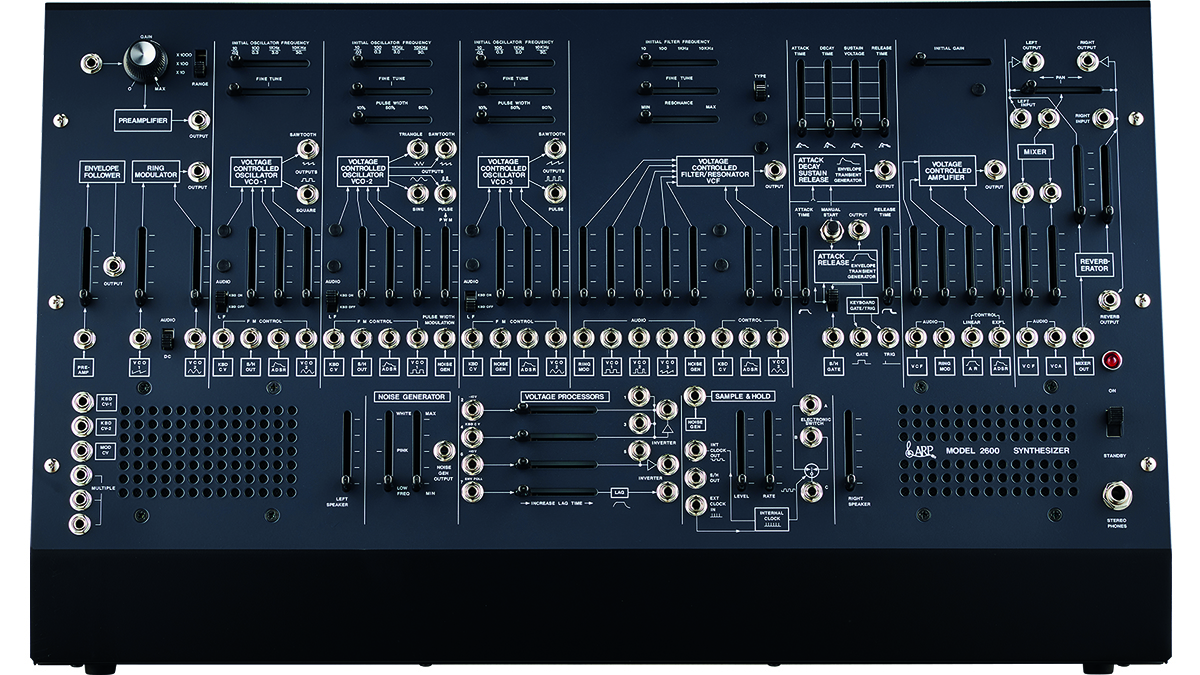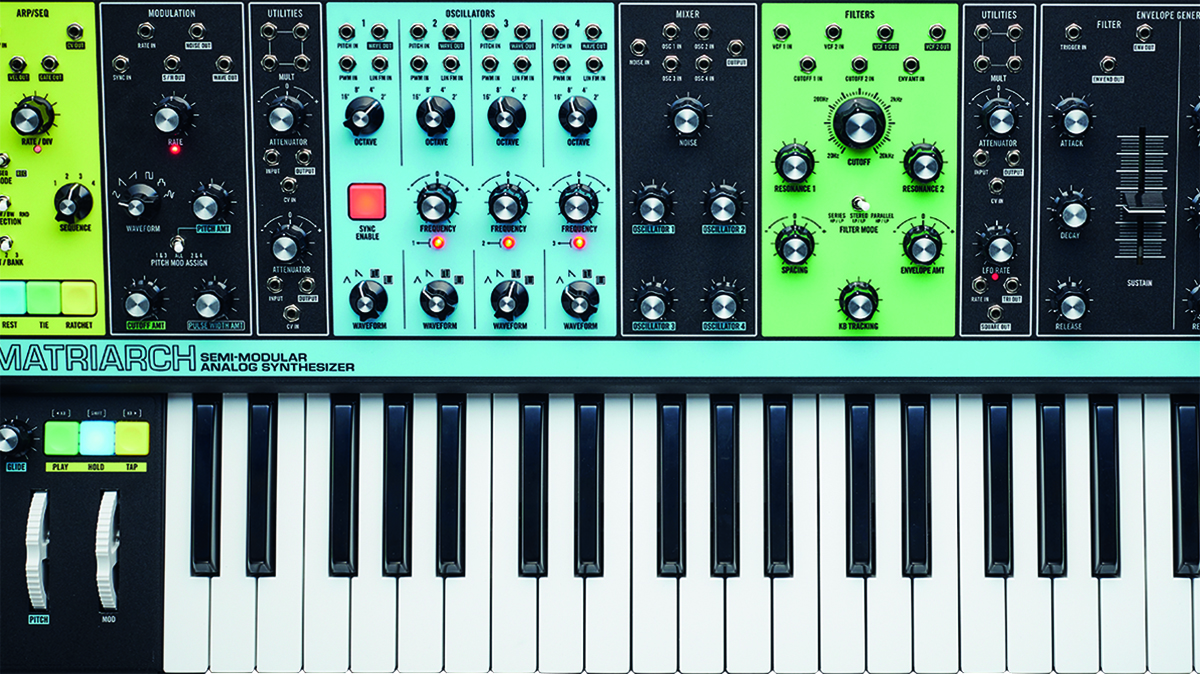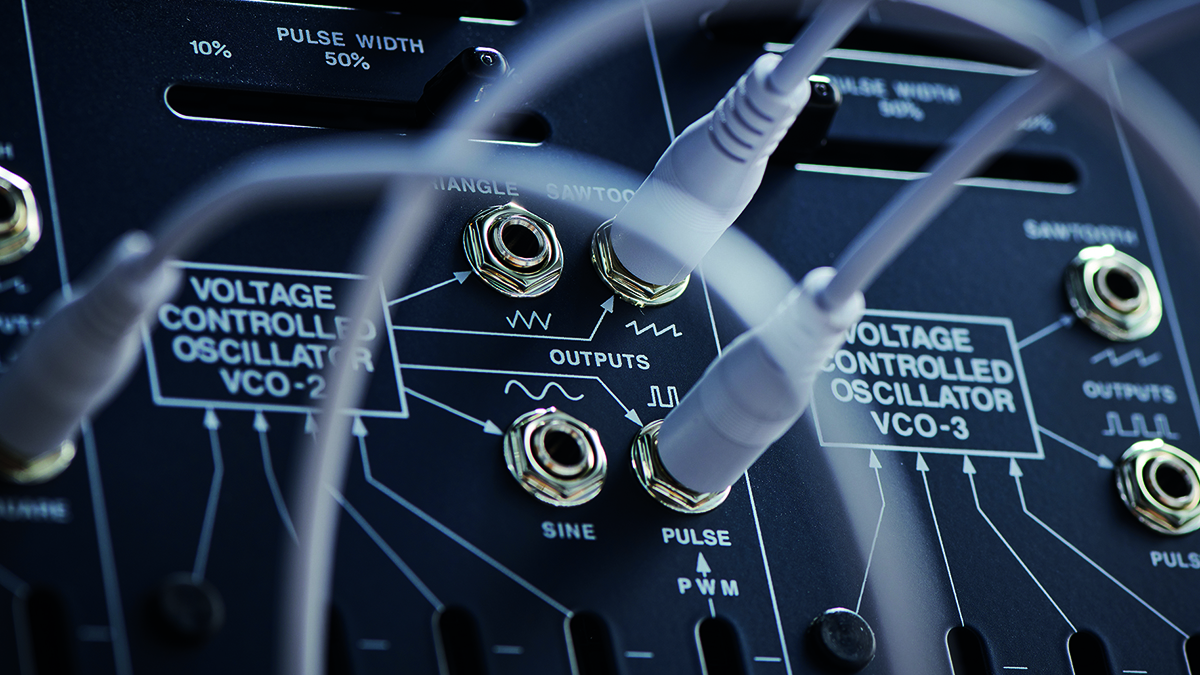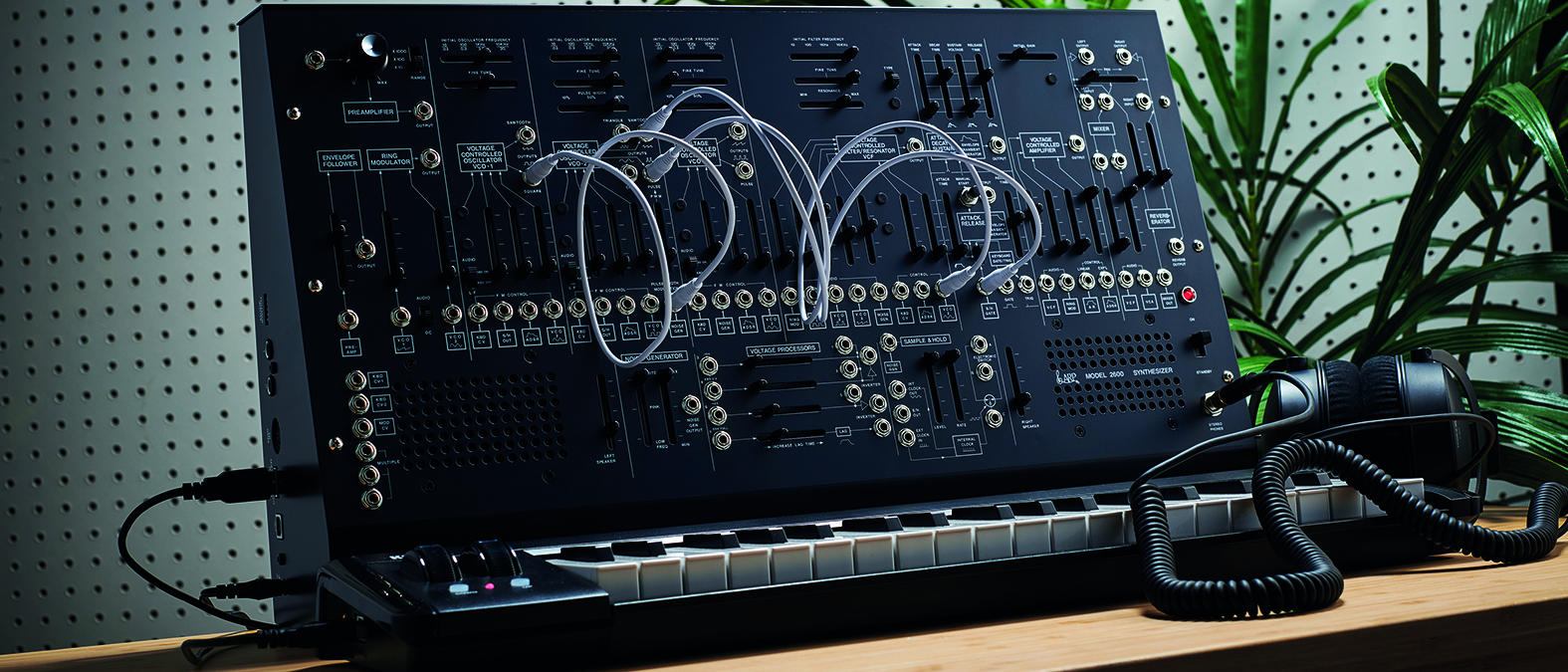MusicRadar Verdict
Neither the most expensive, nor cheapest, take on this classic, but for capturing the allure of the original it ticks the most important boxes.
Pros
- +
It looks like a (small) 2600 – and sounds like a 2600.
- +
Extremely flexible sound design tool.
- +
Integrates well with modular gear.
Cons
- -
No dedicated LFO.
- -
Limited envelope options.
- -
Small sliders on the dark case can be tricky to see.
MusicRadar's got your back
Korg ARP 2600 M: What is it?
Just where do you start a review of a legendary synth on which everyone has an opinion? Perhaps not by trawling the internet to find out what defines the 2600 sound, or why a particular make of clone is/isn’t true to the original. In fact there are likely more views on this matter than there are original working ARP 2600s in existence.
Let’s also remember that the ARP 2600 itself went through a host of design changes (not always representing improvements) and it’s impossible to travel back in time to hear what one of them sounded like when new.
Such is the world that Korg stepped into when it released its limited-edition Korg ARP 2600 FS in 2020. This was a beautifully presented clone of the 2600 (with switchable filter types reflecting one of the main sonic differences between early and mid-’70s units) and came in an authentic case alongside a matching controller keyboard. The downside – a nearly £3,500 outlay and very limited availability.
Korg has now responded with a smaller keyboard-less version in the form of the 2600 M. Like its sibling it employs surface-mount components, adds MIDI connectivity and some small functional tweaks. However, despite losing the sturdy wooden case and matching keyboard of the FS, in broader sonic terms it is the same beast.
Possibly to counter the competition from elsewhere, Korg is also keen to suggest that the 2600 M is not mass-produced, but more of a quality boutique investment with limited monthly production numbers. How this is perceived will perhaps determine its long-term success.

Korg ARP 2600 M: Performance and verdict
So what exactly is a 2600 and what has allowed its design to hold its place among the true classics? At its core it’s an all-analogue three-oscillator synth. Each independently tuneable oscillator (alongside a noise source and the ring-modulated outputs of VCO 1 and 2) are sent to a low-pass filter section (VCF) and then amp (VCA) stage. Two envelopes (a 4-stage ADSR and 2-stage AR) can then be used to modulate parameters relating to oscillator frequency, filter-cutoff and VCA level.
There are also some controls and sections for modulating one oscillator from another, for noise shaping, sample & hold, clocking, signal inversion and switching as well as lag generators, an audio input with envelope follower and spring reverb to boot.
Want all the hottest music and gear news, reviews, deals, features and more, direct to your inbox? Sign up here.

• Moog Matriarch
The Moog Matriarch expands its smaller semi-modular Mother synth with more oscillators, filter, envelopes and connectivity.
• Antonus 2600
Based on the TTSH DIY version of the 2600, this hand-built synth claims to be the next best thing to an original ’70s grey-face.
• Arturia MatrixBrute
Arturia eschews patch cables for a visual modulation matrix and full patch recall – though you’ll still find plenty of sockets on its rear.
Despite some of the hard-wired modulation options, one could argue that this is in some ways little more than a standard Minimoog-style monosynth, and also one that is somewhat deficient when it comes to the number of envelopes, LFO sources and filter shapes. However, if all you want is a playable pre-configured synth then the ARP Odyssey could well be a better fit, and a very fine one at that – after all, they do share a number of the same sonic building-blocks.
Where the 2600 really comes into its own is in the sheer range of its pre-configured or switchable modulation and control routings, all married to a host of patchpoints for overriding or adding to them. In other words, it can do conventional, but also weird, nasty, complex and a whole host of other adjectives often more associated with modular synthesis.
So while it will allow you to create great basses, leads and percussion sounds, it is also an experimenter’s synth, where chance slider movements or random patching can deliver interesting results. However, for those used to easily switchable oscillator wave-shapes, exact tuning increments and patch memories, some disappointment awaits.
Compared to the original ARP 2600, the new Korg version sports USB sockets for connecting both a computer and a MIDI controller (though the MIDI spec is very basic). The review unit – being one of the first 1,000 made – came with a KORG microKEY2-37 keyboard (stored in the impressive custom silver wheelie case with orange trim). This sat neatly in front of the 2600 M, but sadly lacks the arpeggiation, sequencing and LFO capabilities of the FS version’s 3620 keyboard.
Of more concern was the raised noise floor and noticeable digital mush heard when the microKEY was plugged in. Even without this connected the overall background noise was more noticeable than on the Antonus 2600 clone.

Two filter versions are included here, though the difference between them is subtle. Of more noticeable effect is the unit’s size. Although its shrunken status does make it easier to place in the studio, and also for smaller patch cables, this does mean that the shorter sliders make fine adjustment harder.
It also has to be said that the black-on-dark-grey colour scheme makes finding their current position tricky unless they’re well lit – some 2600 clones (like the Antonus and Behringer) employ illuminated sliders. However, if you are willing to forgo the authentic decor then more colourful replacement fader caps might be in order.
The relatively ardent line on authenticity might also have been broken by providing one or two dedicated LFOs (rather than having to rope in one of the oscillators for the task) – and maybe some additional multiples and VCA stages would have been nice. Perhaps the built-in loudspeakers could have been removed to make room for some of these?

We compared the Korg ARP 2600 M to a range of hardware and software equivalents. Next to the Antonus it sounded a little more refined, but this seemed to largely be down to the latter’s ability to drive its amp and mixer stages into distortion more easily (which also altered the way the envelopes responded in some situations).
One oddity was the Korg’s VCO-1 square wave, which was noticeably purer-sounding than both the Antonus, an Arturia software emulation or even the synth’s own VCO-2 output, which all have some even harmonics added to the odd-only mixture of a truer square wave. This may simply be related to the VCO duty-cycle calibration.
Other than these points, it was surprising how close one could get the various comparison synths to respond on simple patches. As we found when comparing an original Prophet-5 to a recent reissue unit, the addition of some very low-level distortion (in that case from a Neve 542 Tape Emulator) can often be enough to provide the last piece of ‘authentic vintage magic’ to the puzzle.
A synth that can rustle up conventional analogue tones but also provide the flexibility for further exploration
So where does Korg’s new ARP 2600 M fit into the current synth landscape? For those who want a very capable synth that can rustle up an array of more conventional analogue musical tones – but at the same time providing the flexibility for further exploration – it ticks many boxes. It would also serve as an ideal springboard to modular synthesis, or even as an excellent complement to an existing rig.
ARP’s old rival Moog has the semi-modular Matriarch which sits in a very similar price bracket and offers benefits such as an additional VCO, dedicated LFOs, dual filters and a built-in keyboard. However it lacks the envelope follower, lag processor and a few other elements on the 2600. Arturia’s MatrixBrute – again in the same price band – offers a decent complement of socket connectivity alongside a programmable patching system that facilitates full patch recall.
For those who missed out on the full-size Korg 2600, the Antonus represents a more imposing presence and one that claims to have the sound and control range of a ’70s classic-era 2600. However, its larger size, robust case and ability to be driven harder than the Korg, come at a significant uplift in price (though still well under that of a refurbished original). Notwithstanding any sonic differences, the Antonus (like the original and TTSH, its DIY progenitor) employs through-hole components, which makes for much easier maintenance or modification in the longer term.

We cannot, of course, also ignore the elephant in the room when it comes to recent recreations/reimaginings of classic synths – Behringer. At around £500, its rack-mount 2600 Gray Meanie loses the loudspeakers but gains some useful additional features. There will always be quality concerns when price is squeezed so much (such as the lack of chassis support for the sockets) – and reputation counts for a lot when shelling out hundreds or thousands on a synth – but only time will be the judge on this front.
There are also many plugin takes on the 2600, including TimewARP 2600 and versions from Arturia and Cherry Audio.
Ultimately, direct comparison of so many competing versions can be fruitless as they often feature different parameter ranges or improved features. However, given Korg’s pedigree and the fact that they teamed-up with ARP co-founder David Friend to produce their version, you’d expect to be in a relatively safe pair of hands. What’s perhaps more important though is how the 2600M sounds – and the answer is ‘very good.
MusicRadar verdict: Neither the most expensive, nor cheapest, take on this classic, but for capturing the allure of the original it ticks the most important boxes.
Korg ARP 2600 M: The web says
"It not only brings the legendary analog semi-modular synthesizer into a more manageable format, but also provides the modern connections and Eurorack-compatible voltages needed in today’s setups."
Gearnews.com
Korg ARP 2600 M: Hands-on demos
Loopop
Alex Ball
BoBeats
Doctor Mix
Korg ARP 2600 M: Specifications
- 3 x VCO, low-pass VCF (two types – early and late 24 dB/oct), VCA, 2 x Envelopes (AR and ADSR), Noise Generator (white and pink), Ring Modulator, Sample & Hold.
- I/O: External Audio Input, MIDI IN, USB port x 2 – Type A and Type B.
- Dimensions: 520 × 129 × 311mm.
- Weight: 6kg.
- CONTACT: Korg
